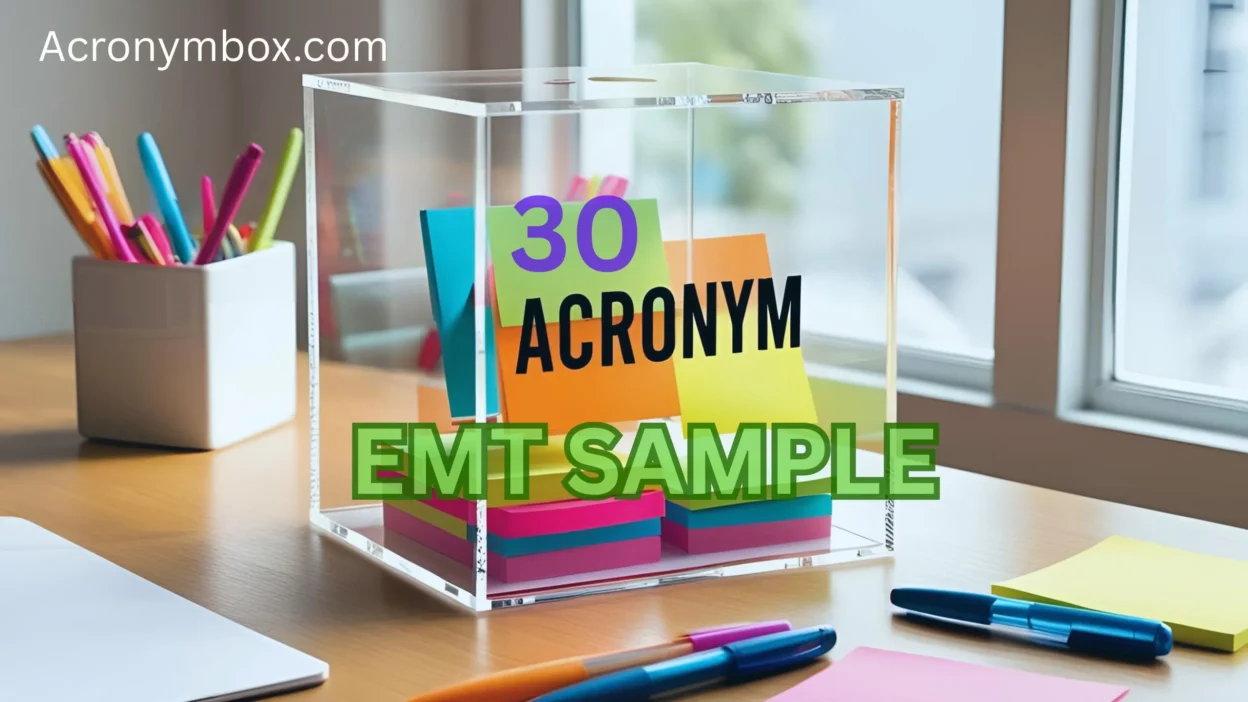If you’ve ever taken a first aid or emergency medical training course, you’ve likely heard of the “SAMPLE” acronym—a key memory tool used by EMTs (Emergency Medical Technicians) and other first responders to quickly gather patient history.
But did you know that SAMPLE has inspired dozens of variations and alternatives that can be just as useful, depending on the emergency situation, patient type, or communication style?
In this guide, we’ll explore the original EMT SAMPLE acronym, explain its deeper purpose, and introduce 30 alternative acronyms that can be used to adapt your assessment style, improve emergency communication, or simply enhance your EMS vocabulary.
🚑 What is the EMT SAMPLE Acronym?
SAMPLE is a mnemonic that helps emergency responders gather essential patient information during an assessment. It stands for:
- S – Signs and Symptoms
- A – Allergies
- M – Medications
- P – Past Medical History
- L – Last Oral Intake
- E – Events Leading Up to the Incident
This tool is designed to guide EMTs through a structured and efficient medical history interview, even in high-pressure or chaotic environments. It also helps ensure nothing critical is overlooked—whether you’re assessing a conscious patient or relaying information to hospital staff.
💡 30 Acronym-Based Alternatives to SAMPLE
Here are 30 acronyms inspired by or related to SAMPLE. Some are used in emergency response, others are helpful in adjacent fields like nursing, military medics, or disaster triage. We’ll explain what each one means, when to use it, and how it compares to SAMPLE.
1. OPQRST
Used for evaluating pain or symptoms.
Onset, Provocation, Quality, Radiation, Severity, Time
Use for chest pain, trauma, or unexplained symptoms.
“Let’s go through OPQRST to assess your abdominal pain.”
2. DCAP-BTLS
A trauma assessment checklist.
Deformities, Contusions, Abrasions, Punctures, Burns, Tenderness, Lacerations, Swelling
Use for physical trauma exams.
“We checked the chest for DCAP-BTLS signs.”
3. AVPU
A scale to assess consciousness.
Alert, Verbal, Pain, Unresponsive
Use early in any primary assessment.
“The patient is responsive to verbal stimuli—AVPU score: V.”
4. AEIOU-TIPS
Identifies causes of altered mental status.
Alcohol, Epilepsy, Insulin, Overdose, Uremia, Trauma, Infection, Psych, Stroke
Use for unconscious or confused patients.
“AEIOU-TIPS helped rule out diabetic issues.”
5. CHART
A reporting format.
Chief Complaint, History, Assessment, Rx (treatment), Transport
Use for writing reports or hospital handoff.
“We documented it using CHART format.”
6. SOAP
Common in medical documentation.
Subjective, Objective, Assessment, Plan
Use for clinical notes.
“Let’s draft a SOAP note for this case.”
7. BLS
Basic Life Support.
Use to describe standard CPR/airway care.
“He received BLS until the paramedics arrived.”
8. CAB
CPR priority steps.
Compressions, Airway, Breathing
Use in cardiac arrest protocols.
“Start with CAB during CPR—compressions first.”
9. TICLS
Pediatric assessment for appearance.
Tone, Interactiveness, Consolability, Look/Gaze, Speech/Cry
Use for evaluating infants or children.
“The baby scored low on TICLS—transport immediately.”
10. MIST
Trauma report format.
Mechanism of injury, Injuries found, Signs/symptoms, Treatment
Use when handing off trauma patients.
“I gave the ER a MIST report over the radio.”
🧠 20 More EMT Acronym Alternatives with Specific Use Cases
11. PENMAN
Scene safety approach.
PPE, Environment, Number of Patients, Mechanism, ALS Needed, Need for Extrication
Use before approaching a potentially dangerous scene.
“Always perform a PENMAN check first.”
12. SAMPLE-R
SAMPLE with an added “R” for Risk.
Use when environmental or lifestyle risks are relevant.
“We added Risk factors to SAMPLE for more detail.”
13. ABCDE
Primary trauma survey.
Airway, Breathing, Circulation, Disability, Exposure
Use in life-threatening trauma assessment.
“We followed ABCDE at the crash site.”
14. PEARL
Eye response check.
Pupils Equal And Reactive to Light
Use during neurological exams.
“The patient’s pupils were PEARL.”
15. SLUDGE
Used in poisoning or organophosphate exposure.
Salivation, Lacrimation, Urination, Defecation, GI upset, Emesis
Use for toxicology-related calls.
“Symptoms matched SLUDGE—antidote administered.”
16. RICES
Soft tissue injury treatment.
Rest, Ice, Compression, Elevation, Stabilization
Use for sprains and strains.
“We applied RICES for the swollen ankle.”
17. TRIP
Initial impression steps.
Tone, Respiration, Interaction, Position
Use with pediatric patients.
“TRIP assessment showed labored breathing.”
18. PQRSTU
Expanded pain assessment.
Provokes, Quality, Region, Severity, Timing, Understanding
Use for chronic or recurring pain.
“Use PQRSTU when pain has multiple layers.”
19. CUPS
Severity classification.
Critical, Unstable, Potentially Unstable, Stable
Use to triage patient urgency.
“This is a CUPS ‘critical’ case.”
20. TACO
IV fluid management.
Type, Amount, Color, Output
Use in advanced care or hospital settings.
“Documented the IV using TACO protocol.”
✨ Context-Based Alternatives (Acronyms That Fit Special Situations)
21. HPI – History of Present Illness
Use in long-form documentation.
22. MOI – Mechanism of Injury
Use for trauma-related calls.
23. PMH – Past Medical History
Used in nearly all clinical documentation.
24. NAD – No Apparent Distress
Used when patient appears stable.
25. VS – Vital Signs
Always recorded during assessments.
26. PERRLA – Pupils Equal, Round, Reactive to Light & Accommodation
Used in full neuro checks.
27. RRR – Regular Rate & Rhythm
Use in cardiac assessments.
28. LOC – Level of Consciousness
Vital for ongoing monitoring.
29. ETA – Estimated Time of Arrival
Used when coordinating transport.
30. BSI – Body Substance Isolation
Use before patient contact for PPE safety.
🎯 How to Choose the Right Acronym
Choosing the right acronym depends on:
- Scene environment – Is it trauma, medical, pediatric, or hazmat?
- Patient condition – Are they responsive? Conscious? Critical?
- Communication goal – Are you documenting, reporting, or diagnosing?
- Time sensitivity – Do you need a quick primary survey or a detailed workup?
For Example:
- Use SAMPLE or OPQRST during initial patient interviews.
- Use DCAP-BTLS during physical exams.
- Use MIST or CHART when preparing for hospital handoff.
✅ Conclusion
The SAMPLE acronym is more than just a checklist—it’s a mindset: stay organized, stay focused, and never forget the fundamentals.
With dozens of alternatives available, EMTs and healthcare professionals can tailor their assessments and documentation to suit the situation, optimize communication, and improve patient outcomes. Whether you’re learning or refreshing, having a mental “acronym toolbox” is essential.
Stay calm. Stay structured. Stay prepared.
Just like the best EMTs do.




